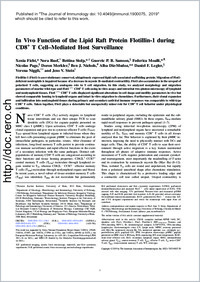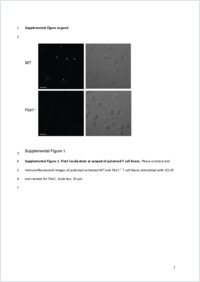In vivo function of the lipid raft protein flotillin-1 during cd8+ t cell–mediated host surveillance
- Ficht, Xenia Theodor Kocher Institute, University of Bern, Switzerland
- Ruef, Nora Department of Oncology, Microbiology and Immunology, University of Fribourg, Switzerland
- Stolp, Bettina Theodor Kocher Institute, University of Bern, Switzerland - Department for Infectious Diseases, Integrative Virology, University Hospital Heidelberg, Germany
- Samson, Guerric P. B. Biotechnology Institute Thurgau at the University of Konstanz, Kreuzlingen, Switzerland
- Moalli, Federica Theodor Kocher Institute, University of Bern, Switzerland - Scientific Institute for Research and Healthcare, San Raffaele Scientific Institute, Milan, Italy
- Page, Nicolas Department of Pathology and Immunology, University of Geneva, Switzerland
- Merkler, Doron Department of Pathology and Immunology, University of Geneva, Switzerland
- Nichols, Ben J. Medical Research Council Laboratory of Molecular Biology, Cambridge, United Kingdom
- Diz-Muñoz, Alba Cell Biology and Biophysics Unit, European Molecular Biology Laboratory, Heidelberg, Germany
- Legler, Daniel F. Biotechnology Institute Thurgau at the University of Konstanz, Kreuzlingen, Switzerland
- Niggli, Verena Institute of Pathology, University of Bern, Switzerland
-
23.09.2019
Published in:
- The Journal of Immunology. - 2019, vol. 203, no. 9, p. 2377-2387
English
Flotillin-1 (Flot1) is an evolutionary conserved, ubiquitously expressed lipid raft– associated scaffolding protein. Migration of Flot1-deficient neutrophils is impaired because of a decrease in myosin II–mediated contractility. Flot1 also accumulates in the uropod of polarized T cells, suggesting an analogous role in T cell migration. In this study, we analyzed morphology and migration parameters of murine wild-type and Flot1−/− CD8+ T cells using in vitro assays and intravital two-photon microscopy of lymphoid and nonlymphoid tissues. Flot1−/− CD8+ T cells displayed significant alterations in cell shape and motility parameters in vivo but showed comparable homing to lymphoid organs and intact in vitro migration to chemokines. Furthermore, their clonal expansion and infiltration into nonlymphoid tissues during primary and secondary antiviral immune responses was comparable to wild-type CD8+ T cells. Taken together, Flot1 plays a detectable but unexpectedly minor role for CD8+ T cell behavior under physiological conditions.
- Faculty
- Faculté des sciences et de médecine
- Department
- Département de Médecine
- Language
-
- English
- Classification
- Biological sciences
- License
- License undefined
- Identifiers
-
- RERO DOC 327732
- DOI 10.4049/jimmunol.1900075
- Persistent URL
- https://folia.unifr.ch/unifr/documents/308405
Other files
Statistics
Document views: 99
File downloads:
- ste_ivf.pdf: 124
- ste_ivf_sm1.pdf: 80

